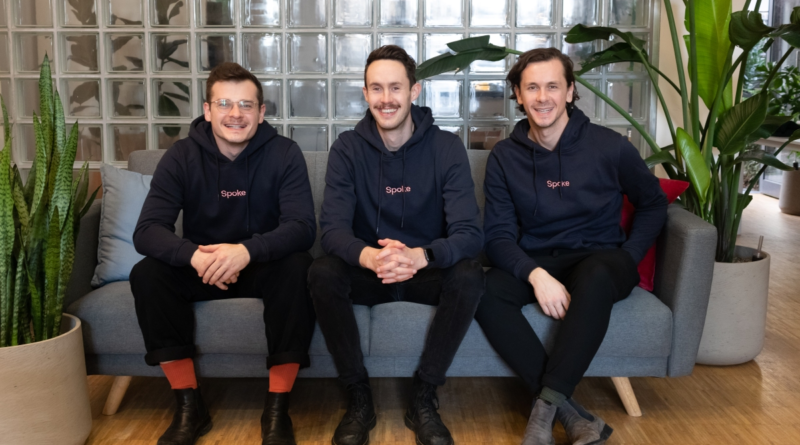Spoke AI is using generative AI to pull signal from workplace noise
As generative AI’s fast-unfolding power to supercharge content-creation amps up concern over what automation might mean for free access to quality information online, Berlin-based startup Spoke AI is gearing up to apply generative AI in a more bounded (but still noisy) context: Internally, within businesses — pitching information workers on tools to help them stay on top of inbound comms by automatically summarizing what’s coming at them across a range of third party tools.
The startup’s vision — eventually — is to be able to offer AI productivity tools that can serve workers across the whole company. But it’s starting by targeting AI-powered aggregation and summarization tools at project managers specifically.
The thinking here is this cohort of desk workers tends to tap into a wide range of third party software programs — such as Slack, Jira, Github, Miro, Figma and Notion — and may therefore have a greater need for assistance to stay on top of so many decentralized, incoming pings. Later, once the startup has worked on honing its tech and building up fresh training data-sets, the plan is to go vertical by vertical, launching products that can serve all sorts of information workers.
Spoke AI opened up access to its first beta tools earlier this week — and says it has around 20 testers, with a wait-list of over 500 companies wanting to give the tech a try. Early interest is coming from businesses of a range of sizes from SMEs with around 10 staff up to companies of some 250 staff. It has also larger enterprises in its sights for one of the first features it’s developing.
Its pitch has grabbed early interest from investors as the Q1 2021-founded startup is announcing a €2 million (~$2.1M) pre-seed round of funding led by the early stage Northern European focused byFounders fund, with participation from Possible Ventures. The funding includes a grant from the European Regional Development Fund via Berlin regional development bank, IBB. Prior to the pre-seed, the team had also taken in some angel funding to build their MVP.
“The way that we apply [AI] is to basically reduce the noise that people face in their daily work across many different tools and platforms that they use,” explains co-founder Max Brenssell. “Initially, this is for product managers, who typically work across eight to 10 different tools. We help we help them stay on top of all of that work and communication across those different tools, by using AI to aggregate, prioritise and summarise this communication.”
The startup’s starter package — or “workplace operating system”, as its marketing bills it — consists of a search feature that can pull data across a range of third party tools, such as conversations or tickets the user has been tagged in, aggregating this inbound into a “smart inbox” experience which layers on AI-generated “contextualized summaries” as well. Initially, it plans to pilot this with a handful of larger companies.
It is also offering AI-powered summarization “in the context of search”, per Brenssell — a feature it refers to as a “Generative Knowledge Base” (or “intelligent search”) — in the form of a browser plug-in. The search feature allows users to search across connected tools in their “smart inbox” to find answers “in summarised form, rather than finding a link to an outdated page”.
Spoke AI is also offering its automated summarization as a Slack plug-in to earlier adopters — idea being to provide functionality where its target users are already spending a lot of their time, while tapping into existing trusted environments rather than demanding users upload what may be commercially sensitive content to an unknown platform.
There’s a long history of productivity tools offering integrations and aggregations that propose to pull relevant but distributed data into one easier-to-keep-tabs-on location. The added value here is the use of generative AI to produce contextual summaries on top of that in order to — in theory — restore the context that might otherwise be loss as messages are pulled out of their native apps and aggregated into a centralized repository.
Close attention to security and privacy is one point of differentiation Spoke AI claims vs legacy approaches to boosting productivity via aggregation.
“The real secret sauce is really in the summarization that works for this specific use case — has to work in a very kind of very concise, reliable way. And also in a data privacy and data security [safe] way. So this is how we are positioning it and how we’re building it as well,” says Brenssell. “We do work with pre-trained language models, like the ones that are at the core of [OpenAI’s] GPT. But we do a lot of pre- and post-processing in terms of, for example anonymizing data — cleaning the data so that it’s improved from the privacy and safety perspective.”
He says Spoke AI envisages this component potentially powering an additional revenue stream — i.e. if it can sell data anonymization as a service (via an API) to other businesses that want to apply AI models like GPT to their own custom data-sets, in addition to selling AI summarization.
Brenssell also says it might look to turn the core summarization capabilities into an API too — as another tactic for monetizing the technology.
For now, it’s offering a free version of its summarization tech in Slack plug-in form. For the smart inbox feature he says that, at least initially, this will be offered as a SaaS — with tiered pricing depending on the number of integrations, security features etc.
Accuracy is obviously one core component to the startup’s proposition. If the summaries it’s generating fail to properly reflect the context around the notifications Spoke AI might end up creating more work for users — rather than saving them precious time.
Brenssell notes it has built feedback loops into the beta product so users can rate the automated summaries and help it improve the product over time. It is also focusing on showing workings for the automation — so users can track back and figure out the inputs that the AI drew on to build a summary. Creating transparency over this is an early focus, he says.
“This is something that users ask a lot, obviously, how can I trust this?” he notes. “What we tried to do always is to create transparency around where does the data come from that flowed into the summary, and then giving the user kind of a trail, where they can then go deeper if they want to, and really understand where we’re pulling the data from that goes into summary.”
Another question to ponder is whether AI summarization is really enough to sustain a standalone business in its own right? Or whether it may be more useful features that could be added by existing productivity giants. (Microsoft, for example, is a major investor in OpenAI’s ChatGPT conversational interface for generative AI and has talked about bringing the technology to a range of its own software tools. While Google already uses AI for certain ‘smart’ features, such as in its email product, albeit with rather patchy results.)
Asked about this, Brenssell says: “We absolutely expect every one of the big [players] like Notion, Slack etc, to launch AI features. And some of them have already done so — which I think is great. The problem that we’re really solving, though, is that we really summarise and increase your productivity across a range of different tools. Product managers are the most extreme example of that today, because they work across 10 different tools on a daily basis. But we do see that trend also in other verticals, increasingly, where you have more and more specialised tools.
“At some point, you then have communication and information across each of these tools, right? So we really see the value in building this very flexible, integrations focused summarization layer — so that you can use all of those tools that make you more productive in very specific tasks and areas. But you can also stay sane, by keeping an overview across the communication that happens on our system.”
“Lots of companies that work with Jira from Atlassian, they prefer to use Notion over Confluence, because it’s the more flexible tool for documentation. And these kinds of things we see, increasingly, because there are just more and more better tools out there,” he adds. “People don’t want to necessarily bind themselves to just one product. But they really want to be able to pick and choose the best tools for their team for their workflow for their company. So that’s kind of what’s what we see in the market. And that’s what we’re obviously also betting on.”
Isn’t applying generative AI to fight information overload when automation is itself predicted to vastly complicate the signal-to-noise problem — a little bit, well, self defeating? AI to counter AI is an arms race the movies suggest might not end that well…
Brenssell says it’s an “interesting point”, adding that it will be “really interesting to see where, where generative AI tools in the sense of really generating content are going in the next few years”. But for Spoke AI’s target arena he reckons the risk is low — arguing that business comms aren’t an obvious target for automating with AI, whereas “most of the generative AI applications, for example, copy creation, or writing outreach emails, are more external facing”.
“We’re really focusing on how teams work within their companies, and how they can become more efficient there. And there, we haven’t seen so many [uses of] generative AI,” he adds.
On the competition front, he concedes certain products do already offer summaries related to features within their own products, such as Notion and Intercom. He also points to inbox aggregators which can, for example, pull in WhatsApps and iMessage into one interface — or put b2b email and Slacks into one inbox. “But nothing that really builds in the summarization, which we believe in is just as the big the big differentiator,” he argues.
But how defensible is the idea of using AI for summarization? With powerful AI models like GPT already out there, what’s to stop others building out the same feature? On this, he suggests the team’s focus on “data privacy” and ethical data use — in addition to pushing on product performance so the tech can serve up “concise and reliable” summaries — will help it carve an edge. “[Summarization is] not as easy to do as generating, for example, content using AI,” he argues. “Obviously, the underlying technology is evolving. We’re following that. But we do think that by building the right pieces — like, for example, when it comes to anonymizing data, then I think that’s where we can keep the edge on the AI side.
“And then the second bit is really on the kind of product application side. Just building an extremely well-integrated user experience that works super well across your different tools — rather than forcing you to switch from one to the other, from your existing tools like Slack, to a new tool. This is not something that we believe in, because it does create a lot of friction. So we’re really trying to find a way to fit our summarization into existing workflow, and into taking a very integrated [approach].”
The startup is using a blend of AI models and custom training for the summarization — with Brenssell saying it’s “currently powered by a combination of fine-tuned pre-trained language models (e.g. Luminous, GPT-3.5), self-hosted open-source technology (e.g. GPT-J, BLOOM, technologies developed by Microsoft and Stanford), and custom models trained in-house (e.g. for Named Entity Recognition, PII Detection, Data Pseudonymization, Question / Answer Identification, Semantic Search)”.
“Having worked with NLP technologies over the recent years and seeing the rapid advancements, we believe that in a space where the core technology will become more and more commoditized, it is still possible and crucial to differentiate,” he also tells TechCrunch. “We think that differentiation in our space mainly comes via building with a clear focus on data privacy, responsible, human-centred AI, and augmentation instead of automation. Building trust with users will be paramount and security- and user experience-enhancing data pre- and post-processing will play a crucial role. We’re eager to rapidly validate specific use cases with easily accessible technologies and then double down by building proprietary datasets based on implicit and explicit feedback, further fine-tuning and training our models.”
Commenting on the pre-seed raise in a statement, Casper Bjarnason, investor at byFounders, added: “As work becomes increasingly distributed and asynchronous, companies need the tools to efficiently share information and create alignment. Spoke is building exactly that, and when we first met the founding team we were blown away by their product vision. We’re so excited to partner with Max, Jack, and Carl on their journey ahead!”




